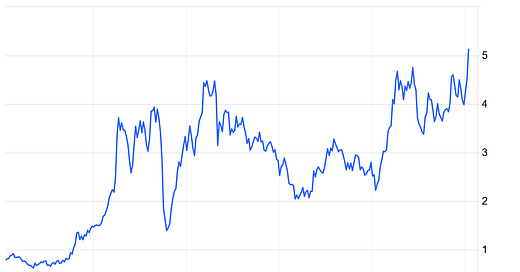Copper futures continue to hover near record highs, with prices around $5.1 per pound. A surge in copper prices is often seen as a positive indicator, reflecting strong industrial demand and a booming global economy. As a key component in construction, electrical wiring, and manufacturing, copper is frequently referred to as ‘Dr. Copper’ - a metal with a PhD in economics due to its predictive power over economic trends.
However, this time, the rally appears increasingly fragile, driven more by short-term speculation and supply constraints rather than a sustainable economic recovery.
First of all, the looming possibility of US tariffs on copper imports has sparked a flurry of preemptive buying, artificially tightening supply. President Trump’s recent executive order, which frames copper imports as a national security risk, has raised concerns that a 25% tariff could soon be implemented. This has led traders to rush in and secure shipments before any restrictions are imposed, pushing prices higher.
Secondly, any organic demand for copper should stem from economic growth or industrial production in major economic hubs - the United States, Europe, and especially China. However, as we’ve discussed in recent days, the outlook is bleak across the board, particularly in Europe and China.
For instance, China’s latest economic moves add another layer of uncertainty. Beijing has set an ambitious 5% GDP growth target and raised its deficit to the highest level in three decades. Policymakers have announced plans to stimulate domestic demand and boost consumption, measures that should - theoretically! - support commodity markets. If these measures had truly been effective, we would have seen similar reactions in other commodities as well.
Yet, crucial industrial metals like iron ore and steel are failing to reflect any meaningful optimism. If China’s economy (or the global economy as a matter of fact) were truly rebounding, we would expect Shanghai steel prices - considered a reliable barometer of Chinese construction and infrastructure activity - to rise in tandem with copper. Instead, steel rebar futures remain subdued, with prices at 2017 levels - below those seen during the pandemic crisis when demand was in free fall.
Iron ore prices have also slipped to a one-week low, weighed down by concerns over China’s struggling property sector and weak sentiment in the steel industry. But here, too, the situation is far from promising. Prices are now at levels last seen in April 2020, at the onset of the pandemic crisis. I fail to see how this could be a good sign.
China’s structural challenges further cloud the outlook. The country is pushing forward with plans to restructure its vast steel sector, a move that signals ongoing difficulties rather than a resurgence in demand. The government is even considering compensation funds to phase out outdated capacity, a step that highlights the broader slowdown in industrial activity. Additionally, despite efforts to stabilize its property market, new home prices continue to decline. This suggests that construction - a key driver of steel and copper demand - remains under pressure, raising doubts about the sustainability of any commodity rally.
Even outside of steel and iron ore, weakness is apparent. Cobalt, a critical material for batteries and electronics, has plunged to historically low prices. Despite being a by-product of copper mining, cobalt’s price collapse reflects weak demand from automakers and growing oversupply. Only after discussions in the Democratic Republic of Congo—one of the largest cobalt exporters—about introducing export quotas did cobalt prices begin trending upward.
However, once again, this is an artificial increase that does not reflect an improvement in demand. Moreover, since cobalt is a by-product of copper production, this situation has also contributed, to some extent, to the artificially induced rally in copper prices.
Do we even need to discuss gold? In recent days, the price of gold - measured in USD per troy ounce - has reached $3,021. The well-established relationship between gold and (macro)economic conditions needs no introduction. A steep surge in this safe-haven asset can only indicate that we are in a period of economic, industrial, and overall stagnation.
If global industrial activity were genuinely strengthening, we would expect a more synchronized recovery across the commodity space. Instead, the divergence between copper’s surge and the stagnation in other industrial metals underscores a troubling reality, this rally is built on shaky foundations, and the risk of a sharp correction looms large.








Perhaps the latest generation of copper got their PhD's in a woke institution and no longer understands their role 😂
But seriously, I agree 100% that something is out of whack there, and that Europe and China, and probably the US, are about to see slower growth.